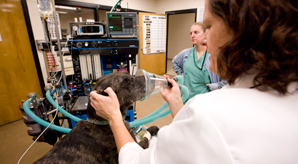The process for administering anesthesia is unique for each patient. We consider your pet's individual needs and tailor our drugs and process to match.
We understand that your knowing your pet is in surgery and anesthetized can cause anxiety and worry. We are committed to providing the most comfortable and safe experience for your pet and you, and it may help to view our Anesthesia Process so you can understand more about the experience your pet will have. Visit the American College of Veterinary Anesthesiologists the for general information about What to Expect When Your Pet Needs Anesthesia.
- Preanesthetic Evaluation
Our team will want to make sure your pet is in the best possible condition before surgery and anesthesia. You will be asked important questions about your pet's general health, including whether he or she has difficulties with anesthesia.
A thorough evaluation of the history, physical condition, and past and current medication of your pet will be completed before preparing an anesthetic plan. The physical exam emphasizes musculoskeletal, cardiovascular, and respiratory function.
We will then consider the type and duration of the surgery or treatment and document a tailored anesthetic plan for your pet. We will use this plan to evalute, prepare, and conduct the anesthesia administration and recovery of your pet.
Sometimes even minor illnesses such as sniffles and colds may cause problems during some types of surgery and anesthesia. In some cases, we may feel it best to postpone surgery. Remember, however, that we always have your pet's best interest in mind.
- Types of Anesthesia
Depending on your pet's treatment and needs, there are several different types of anesthesia your pet may receive:
- Preemptive analgesia: Prevention or minimization of pain by the administration of analgesics before the production of pain, to provide a therapeutic intervention in advance of pain.
- Local anesthesia: Local anesthesia is the blocking of pain in a specific location of the body, such as a tooth.
- Regional anesthesia: Regional anesthesia blocks pain in a larger area of the body, such as the entire lower half of the body. This occurs by blocking nerve impulses between the brain and the specific region of the body.
- General anesthesia: General anesthesia renders the patient unconcious, as nerve impulse transmission is inhibited in the brain. This "blocks" pain for the patient throughout the entire body.
- Methods of Administration
Anesthetic agents can be administered in several ways:
- Anesthesia can be started by an intravenous injection so the patient becomes unconscious rapidly (this is the most common application of anesthesia).
- Anesthetic agents may be breathed by your animal until they lose consciousness, called inhalation induction.
- In a multimodoal approach, we may administer multiple drugs that act by different mechanisms of action to produce the desired analgesic effect.
- Monitoring
Whenever your pet is anesthetized in our hospital, there is a board-certified anesthesiologist or highly trained anesthesia technician monitoring or supervising a veterinary student who is monitoring your pet's vital signs.
We monitor many characteristics of your pet throughout anesthesia administration, including:
- Respiration:
There are many options for monitoring respiration in the anesthetized patient, from very simple auscultation of the chest and examination of the mucous membranes to use of complex technology such as pulse oximetry, capnography, and mass spectroscopy.
A capnograph provides digital and analog information about the respiratory rate. The amount of carbon dioxide exhaled and inhaled allows evaluation of respiratory depression and any rebreathing.
- Heart rate and pulse strength
- Capillary refill time
- Mucous membrane color
- Arterial blood pressure (direct and indirect)
- Central venous pressure
- Cardiac output (when case warrants)
- Arterial and venous blood gases
- Body temperature
- Acid-base and electrolyte balance
- Pulse oximetry
- Electrocardiography
- Echocardiography
- Side Effects
Although anesthetics can provide complete pain relief and loss of consciousness during an operation, there are occasionally side effects, such as decreased breathing, heart action, and blood pressure. Our team is trained to ensure that these effects are minimized.
- Your Pet's Reactions
Most animals tolerate surgery and anesthesia quite well. Just like their human counterparts, however, animals have natural fears of the unknown. Your composure can be essential and calming to your pet and help them reduce fear and anxiety.
- Your Pet's Recovery
Different pets awaken from anesthesia at differing rates. Some animals may be fully alert upon arriving in the recovery area, while others may be groggy for hours after surgery.
Because operations can produce stress on the body, your pet may have a "sick" feeling post-operation, resulting in nausea and vomiting. Although newer drugs and techniques have reduced these side effects, some animals may require a few days to return to normal. If you have any concerns about your pet's recovery, you should contact your veterinarian immediately.
Horses have unique recovery considerations, which you can read more about on our Horse Recovery From Anesthesia sheet.

